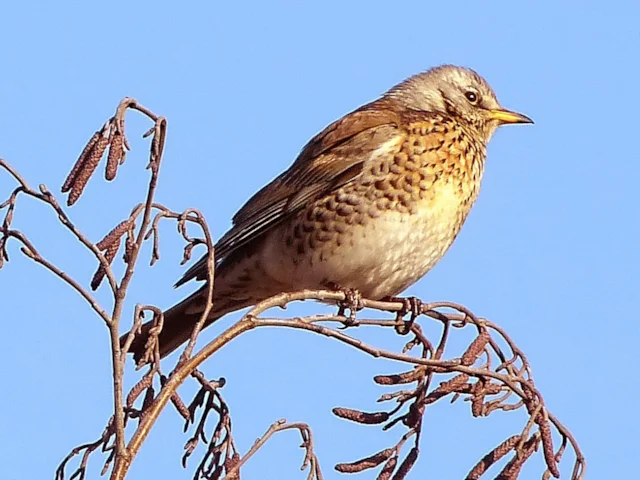Last call for thrush survey
10060fb3-ec16-451f-8f15-e952c5ecb375

The British Trust for Ornithology (BTO) renewed its call for members of the public to look out for thrushes, in particular Redwing and Fieldfare.
This winter members of the public have been monitoring thrushes for the BTO, and the response has been fantastic: more than 640,000 birds have been logged since mid-September from almost 3,000 locations throughout Britain. However, monitoring the arrival of birds is far easier than keeping check on their departure. The arrival of Fieldfares at the beginning of the winter is eagerly awaited by birders and well recorded, but when numbers begin to dwindle during the last days of winter as they leave our shores for northern and eastern Europe, their departure is easily overlooked.
John Marchant, Winter Thrushes Survey organiser at the BTO, said: “The survey comes to an end in mid-April and the next few weeks are critical for logging the departure of our winter-visiting thrushes. We hope to see just when they leave different regions of the country and where their exit points are. Please register a ‘winter walk’ for the survey at the survey's web page and tell us what’s happening in your area.”
Thrushes wintering in Britain include not just Fieldfare and Redwing, but also large numbers of Continental Blackbirds and Song Thrushes, so the changes in numbers are particularly important to estimate the numbers involved in wintering here and to have a good idea of the size and timing of movements.
This has been the second and final winter of the Winter Thrushes Survey. Thrushes wintering in some areas have benefited from a better crop of berries than in the first winter, as well as from milder temperatures. Flooding has restricted their use of low-lying farmland but provided easy access to earthworms and other foods in waterlogged fields. The birds are now on the move. To help the BTO and for more information, please visit the survey's web page.
This winter members of the public have been monitoring thrushes for the BTO, and the response has been fantastic: more than 640,000 birds have been logged since mid-September from almost 3,000 locations throughout Britain. However, monitoring the arrival of birds is far easier than keeping check on their departure. The arrival of Fieldfares at the beginning of the winter is eagerly awaited by birders and well recorded, but when numbers begin to dwindle during the last days of winter as they leave our shores for northern and eastern Europe, their departure is easily overlooked.
John Marchant, Winter Thrushes Survey organiser at the BTO, said: “The survey comes to an end in mid-April and the next few weeks are critical for logging the departure of our winter-visiting thrushes. We hope to see just when they leave different regions of the country and where their exit points are. Please register a ‘winter walk’ for the survey at the survey's web page and tell us what’s happening in your area.”
Thrushes wintering in Britain include not just Fieldfare and Redwing, but also large numbers of Continental Blackbirds and Song Thrushes, so the changes in numbers are particularly important to estimate the numbers involved in wintering here and to have a good idea of the size and timing of movements.
This has been the second and final winter of the Winter Thrushes Survey. Thrushes wintering in some areas have benefited from a better crop of berries than in the first winter, as well as from milder temperatures. Flooding has restricted their use of low-lying farmland but provided easy access to earthworms and other foods in waterlogged fields. The birds are now on the move. To help the BTO and for more information, please visit the survey's web page.

